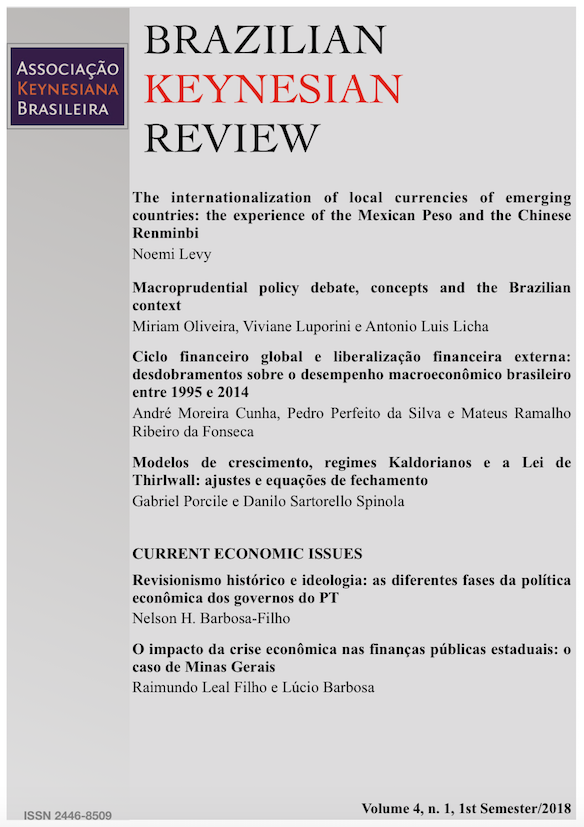Modelos de crescimento, regimes Kaldorianos e a Lei de Thirlwall: ajustes e equações de fechamento
Resumo
Nos modelos de crescimento de corte Kaldoriano, tem-se uma distinção central entre o regime de produtividade (lado da oferta) e o regime de demanda. Estes regimes interagem por meio das taxas de crescimento efetiva (yE) e natural (yN). Um equilíbrio estável requer que essas taxas convirjam. Uma abordagem central da teoria Keynesiana enfatiza o papel da restrição do balanço de pagamentos (modelo de Thirlwall) como determinante da taxa de crescimento de equilíbrio no longo prazo (yBP). Expandimos o modelo Kaldoriano estruturado por Setterfield (2010), associando-o ao modelo de Thirlwall. A partir do estabelecimento de um modelo base, definimos alguns pressupostos teóricos que resultam em equações de fechamento do modelo: (1) elasticidades exógenas e oferta infinita de trabalho (caso Lewis); (2) inelasticidade na oferta de trabalho (caso Kaldor) e (3) elasticidades renda de importações e exportações dependem da taxa de emprego (caso Krugman-Palley). Para cada caso discutimos as implicações do modelo e sua intuição econômica.
Downloads
Referências
Abramovitz, M. (1986) "Catching up, forging ahead, and falling behind", The Journal of Economic History, 46(2,) p. 385–406.
Araujo, R. e Lima, G. (2007) "A structural economic dynamics approach to balance-of-payments-constrained growth", Cambridge Journal of Economics, 31(5), p. 755–774.
Blecker, R. (2009) "Long-run growth in open economies: export-led cumulative causation or a balance-of-payments constraint?" Working Papers American University, Department of Economics. Disponível em: <https://ideas.repec.org/p/amu/wpaper/2009-23.html>. Acesso em 28/09/2017.
Carlin, W. e Soskice, D. (2005) Macroeconomics: imperfections, institutions, and policies. Oxford, UK: Oxford University Press.
Carneiro, R. (2002) Desenvolvimento em crise: a economia brasileira no último quarto do século XX. São Paulo: Editora UNESP.
Catela, E. e Porcile, G. (2012) "Keynesian and Schumpeterian efficiency in a BOP-constrained growth model", Journal of Post Keynesian Economics, 34(4), p. 777–802.
Cimoli, M. e Porcile, G. (2014) "Technology, structural change and BOP-constrained growth: a structuralist toolbox", Cambridge Journal of Economics, 38(1), p. 215–237.
Cimoli, M.; Porcile, G. e Rovira, S. (2010) "Structural change and the BOP-constraint: why did Latin America fail to converge?" Cambridge Journal of Economics, 34(2), p. 389–411.
Dutt, A. (1990) Growth, distribution and uneven development. Cambridge: Cambridge Uiversity Press.
Foley, D. e Michl, T. (1999) Growth and distribution, Cambridge, MA: Harvard University Press.
Gouvea, R. e Lima, G. T. (2010) "Structural change, balance-of-payments constraint, and economic growth: evidence from the multisectoral Thirlwall’s law", Journal of Post Keynesian Economics, 33(1), p. 169–204.
Kaldor, N. (1975) "Economic growth and the Verdoorn Law: a comment on Mr Rowthorn’s article", The Economic Journal, 85(340), p. 891–896.
Krugman, P. (1989) Differences in income elasticities and trends in real exchange rates" European Economic Review, 33(5), p. 1031–1046.
Levine, R. (2005) "Finance and growth: theory and evidence" In: P. Aghion e S. Durlauf (Eds.) Handbook of economic growth, v.1, p. 865–934, Amsterdam: Elsevier.
Lewis, W. (1954) "Economic development with unlimited supplies of labour", The Manchester School, 22(2), p. 139–191.
Lundvall, B-Å. (2007) "National innovation systems analytical concept and development too" Industry and Innovation, 14(1), p.95-119.
Mccombie, J. e Thirlwall, A. (1994) Economic growth and the balance-of-payments constraint. London: Palgrave Macmillan.
Narula, R. (2004) Understanding absorptive capacities in an “innovation systems” context: consequences for economic and employment growth, Maastricht University, Maastricht Economic Research Institute on Innovation and Technology (MERIT).
Nelson, R. (1993) National innovation systems: a comparative analysis. Oxford, UK: Oxford University Press.
Palley, T. (2009) "Imports and the income-expenditure model: implications for fiscal policy and recession fighting", Journal of Post Keynesian Economics, 32(2), p. 311–322.
Prebisch, R. (1950) The economic development of Latin America and its principal problems, New York: United Nations.
Setterfield, M.(2010) "Endogenous growth: A Kaldorian approach" Working Papers Trinity College, Department of Economics.
Setterfield, M. e Cornwall, J. (2002) "Neo-Kaldorian perspective on the rise and decline of the Golden Age", In: M. Setterfield (Ed.) The economics of demand-led growth: challenging the supply side vision of the long-run, Cheltenham: Edward Elgar Publishing.
Thirlwall, A. (1979) "The balance of payments constraint as an explanation of the international growth rate differences", PSL Quarterly Review, 32(128).
Thirlwall, A. (2012) "Balance of payments constrained growth models: history and overview", In: E. Soukiazis e P. Cerqueira (Eds.) Models of balance of payments constrained growth: history, theory, evidence. Basingstroke: Palgrave Macmillan, London, p. 11–49.
Copyright (c) 2018 Gabriel Porcile, Danilo Sartorello Spinola

This work is licensed under a Creative Commons Attribution 4.0 International License.
- Autores mantém os direitos autorais e concedem à revista o direito de primeira publicação, com o trabalho simultaneamente licenciado sob a Licença Creative Commons Attribution que permite o compartilhamento do trabalho com reconhecimento da autoria e publicação inicial nesta revista.
- Autores têm autorização para assumir contratos adicionais separadamente, para distribuição não-exclusiva da versão do trabalho publicada nesta revista (ex.: publicar em repositório institucional ou como capítulo de livro), com reconhecimento de autoria e publicação inicial nesta revista.
- Autores têm permissão e são estimulados a publicar e distribuir seu trabalho online (ex.: em repositórios institucionais ou na sua página pessoal) a qualquer ponto antes ou durante o processo editorial, já que isso pode gerar alterações produtivas, bem como aumentar o impacto e a citação do trabalho publicado (Veja O Efeito do Acesso Livre).


